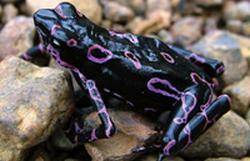At a presentation at the Hotel Krasnapolsky in Paramaribo, representatives of US-based Conservation International (CI) told government officials, reporters and others that among the 24 new species there is a purple fluorescent frog (Atelopus species).
CI also issued a statement reporting on the extraordinary discovery of so many species outside the insect realm. Scientists warned however that the new found creatures are threatened by illegal small-scale gold mining, hunting and other forestry activities.
The Suriname government was called upon to take swift action in declaring the area a protected zone in order for the new species and the biodiversity in the region to survive. Although the places were the discoveries were made - some 130 kilometers south of the capital Paramaribo - are far from civilization they are totally unprotected and threatened by illegal small-scale gold mining thriving in the Suriname interior.

|
| ©Conservation International |
| Purple fluorescent frog (Atelopus species). |
According to CI vice president Leanne Alonso, "It's an opportunity now for all the players, the mining companies who still have mining concessions there, the local communities, the government, the NGOs (non-governmental organizations), to try to make a regional plan for the area."
"Suriname has some of the Amazon's most pristine and intact rainforest, which offers huge potential for scientific research and economic investment in carbon sequestration, as well as the sustenance it has always provided local communities," said Alonso, who heads the RAP program. "Our study will be a vital component in determining how to promote economic development in Suriname while protecting the nation's most valuable natural assets."
The research was co-financed by bauxite producers BHP-Billiton Maatschappij Suriname, a subsidiary of BHP Billiton, and Suriname Aluminum Company LLC, a subsidiary of Alcoa Inc. which are planning gold mining activities in the region. Company officials have indicated that the findings of the research will be included in their environmental effects study of their future plans.
The two international mining companies recently explored the region for bauxite and gold, while these multinationals through their joint-venture company Surgold NV are preparing to negotiate the establishment of a gold mine in the Nassau-mountains.
According to Conservation International the two-tone frog -- whose skin is covered with irregular fluorescent lavender loops on a background of aubergine -- was discovered in 2006 as part of a survey of Suriname's Nassau-mountains. The findings from the 2005 expedition led by Conservation International's Rapid Assessment Program (RAP) and a follow-up survey in 2006 demonstrate the value of exploring unknown regions such as Suriname's rainforest to assess the need to conserve them, the organization said in a statement.
During the RAP on the Nassau plateau and Lely-mountains aside the purple frog four other new frog species (Eleutherodactylus species), six fish species, 12 dung beetle species and a new ant species were found, CI-officials said. The animals were discovered by 13 scientists who explored a region about 130 kilometers southeast of Paramaribo, including areas with enough clean fresh water sources to support abundant fish and amphibians.
"Suriname has some of the Amazon's most pristine and intact rainforest, which offers huge potential for scientific research and economic investment in carbon sequestration, as well as the sustenance it has always provided local communities," said Leeanne Alonso, a Conservation International (CI) vice president who heads the RAP program. "Our study will be a vital component in determining how to promote economic development in Suriname while protecting the nation's most valuable natural assets."
The study further showed that also 27 species endemic to only Suriname, Guyana, French Guiana and northern Brazil were found. One of these was the rare armoured catfish, Harttiella crassicauda, which conservationists feared was extinct because gold miners had contaminated a creek where it was last seen 50 years ago.
During the expedition, researchers found a "virtually unexplored region of mountain savannah forest, high dry land rainforest and palm swamp with freshwater sources clean enough to support abundant fish and amphibian life", said Conservation International. The CI-officials further noticed that including the new species, scientists spotted 467 species at the two sites, ranging from large cats like panthers and pumas, to monkeys, reptiles, amphibians, bats and insects.
In their final report, the scientists call for improved conservation management of the region to address and halt threats from hunting and small-scale illegal mining. The report suggests that strategies should focus on protecting freshwater streams and preventing fragmentation of the natural habitat from unchecked or poorly planned development.



Reader Comments
to our Newsletter